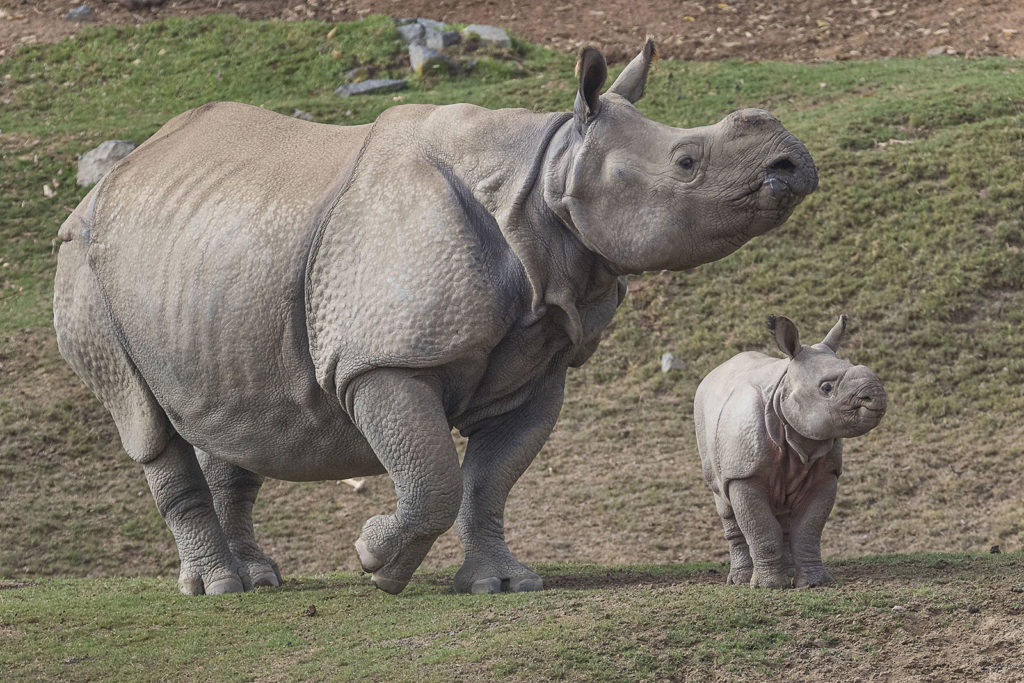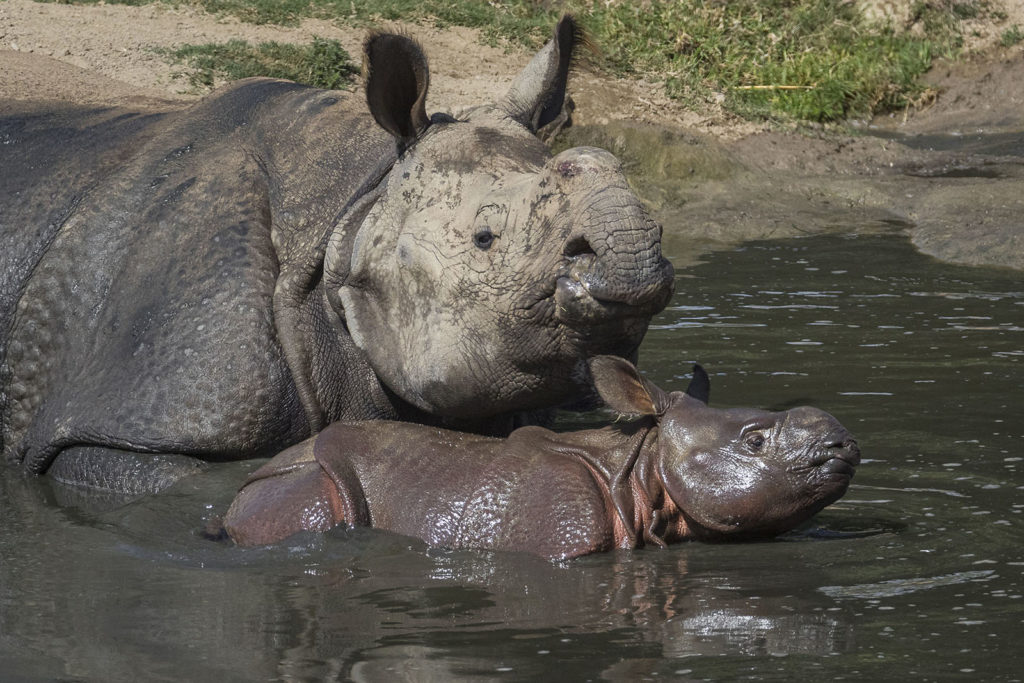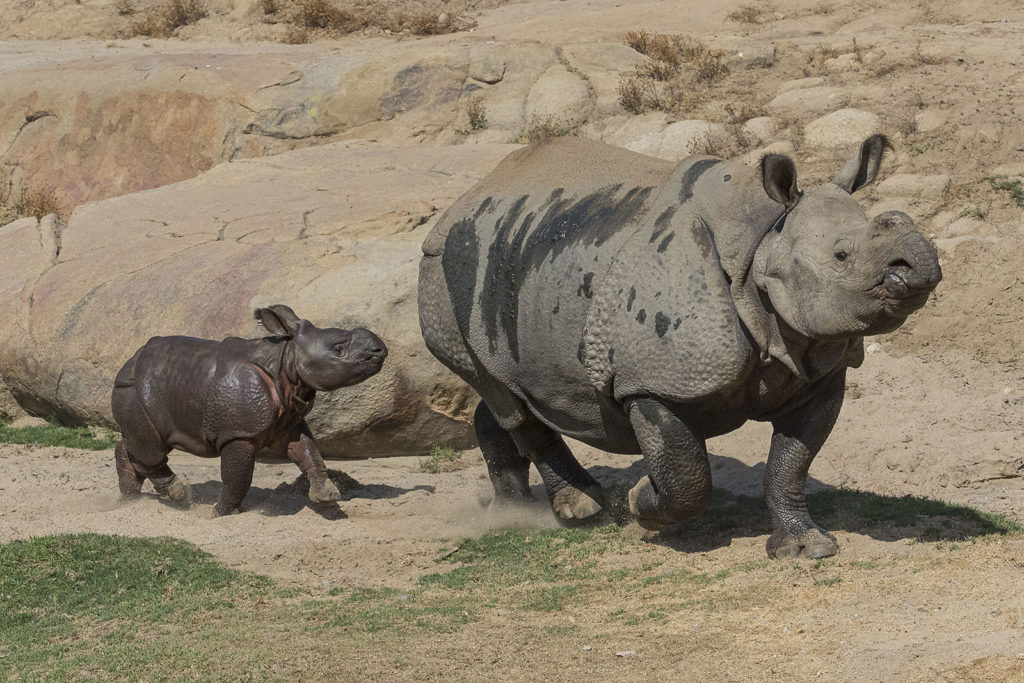
A one-month-old greater one-horned rhino calf and her mother jogged into their expansive Asian Savanna field exhibit together for the first time yesterday (Aug. 28, 2019) at the San Diego Zoo Safari Park. The female calf—named Anusha, which means “beautiful morning” in Hindi—and her mother Alta emerged from a protected area called a boma, where they have been staying since the calf’s birth on July 30. The pair’s one-on-one time in the boma gave them a chance to properly bond before interacting with other wildlife in their 40-acre habitat.
Mother and her timid little offspring exited the boma and jogged around the field habitat before taking a dip in a cool mud wallow. The calf, who never ventured more than a few feet from her protective and doting mom, appeared to enjoy the water before heading out to explore more of the field. “It’s great to see Alta introducing her calf to their exhibit for the first time,” said Jillian King, senior keeper, San Diego Zoo Safari Park. “The calf is a little shy, and mom is very protective. Everything is new to the calf right now, so it will be interesting to watch her acclimate and eventually meet some of the other rhinos, and other animals that share their habitat.”

The greater one-horned rhinoceros was once widespread in Southeast Asia, but it is now found only in India and Nepal. It differs from other rhino species, as it has an armor-plated appearance—but that “armor” is actually a layer of skin that has many folds. While the calf walked, a layer of young, pink skin could be spied underneath the folds of her thickening, dark gray top layer of skin.
The greater one-horned rhino is listed as Vulnerable on the International Union for Conservation of Nature Red List of Threatened Species, primarily due to habitat loss, poaching threats and illegal traffic in rhino horn. There are an estimated 3,500 greater one-horned rhinos remaining in the wild, with over 70 percent of the population living in one reserve: Kaziranga National Park in India. Sadly, in July, Kaziranga National Park was entirely under water because of extremely heavy rainfall this monsoon season and severe floods in the state of Assam, where Kaziranga is located. More than 50 wild animals died trying to escape the flooded sanctuary, including 17 greater one-horned rhinos. All rhino births are significant, and Anusha’s birth is an important addition to the overall population of the greater one-horned rhino.

Rhinos are very important to the ecosystems in which they reside. Greater one-horned rhinos live in humid, swampy, tall-grass habitats. These large herbivores graze on the grass, which helps to maintain the habitat—increasing plant diversity and providing grazing areas for other animals. Rhinos digest large volumes of plant material and disperse the seeds in their dung, thus playing an important role in the health and maintenance of vegetation in their habitat. As rhinos disappear from their habitats, their absence impacts other species, such as birds, reptiles, mammals and plants.
San Diego Zoo Global has been working for more than 40 years, along with other accredited zoos, to keep a sustainable population of rhinos safe under human care while working to protect them in sanctuaries in the wild. Anusha is the 73rd greater one-horned rhino born at the San Diego Zoo Safari Park since 1975, making the Safari Park the foremost breeding facility in the world for this species.

Visitors to the Safari Park may see Anusha and her mom, along with six other greater one-horned rhinos roaming the Asian Savanna, from a Caravan Safari or private Cart Safari.
At the San Diego Zoo Safari Park, more than 1 million guests each year see animals in herds of mixed species, in expansive habitats. Safari tours offer savanna views of African and Asian animals, trails take visitors on treks to experience Australian and North American habitats—plus, there are opportunities for up-close encounters and unique behind-the-scenes perspectives. Known for its leadership in rhino conservation, the Safari Park is home to the Nikita Kahn Rhino Rescue Center, which is devoted to groundbreaking work to bring back the northern white rhino. As visitors discover the rare and endangered species at the Safari Park, they are directly contributing, through admission and on-grounds sales, to the efforts of San Diego Zoo Global, an international nonprofit conservation organization that works to fight extinction through recovery efforts for plants and animals worldwide. To learn more, visit sdzsafaripark.org, or connect with us on Facebook, Twitter, Instagram orYouTube.




